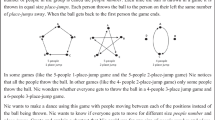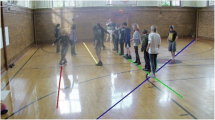Abstract
Using the work of philosopher Henri Bergson (1859–1941) to examine the nature of movement and memory, this article contributes to recent research on the role of the body in learning mathematics. Our aim in this paper is to introduce the ideas of Bergson and to show how these ideas shed light on mathematics classroom activity. Bergson’s monist philosophy provides a framework for understanding the materiality of both bodies and mathematical concepts. We discuss two case studies of classrooms to show how the mathematical concepts of number and function are themselves mobile and full of potentiality, open to deformation and the remapping of the (im)possible. Bergson helps us look differently at mathematical activity in the classroom, not as a closed set of distinct interacting bodies groping after abstract concepts, but as a dynamic relational assemblage.








Similar content being viewed by others
References
Bautista, A., Roth, W.-M., & Thom, J.-S. (2012). Knowing, insight learning and the integrity of kinetic movement. Interchange, 42(4), 363–388.
Bergson, H. (1889/1910). Essai sur les données immédiates de la conscience. (F. L. Pogson: Time and Free Will, Trans.). Whitefish, MT: Kessinger Publishing Company, 1910.
Bergson, H. (1896/1988). Matière et mémoire. (N. M. Paul & W. S. Palmer: Matter and Memory, Trans.). New York, NY: Zone Books, 1988.
Bergson, H. (1903/1999). Introduction à la métaphysique. (T. E. Hulme: An Introduction to Metaphysics, Trans.). Indianapolis, IN: Hackett Publishing Company, 1999.
Bergson, H. (1907/2005). L’Evolution créatrice. (A. Mitchell: Creative Evolution, Trans.). New York, NY: Cosimo Books, 2005.
Châtelet, G. (1993/2000). Les enjeux du mobile. (R. Shore & M. Zagha: Figuring space: Philosophy, mathematics and physics, Trans.). Dordrecht, The Netherlands: Kluwer Academy Press, 2000.
de Freitas, E., & Sinclair, N. (2012). Diagram, gesture, agency: Theorizing embodiment in the mathematics classroom. Educational Studies in Mathematics, 80(1–2), 133–152.
de Freitas, E., & Sinclair, N. (2013). New materialist ontologies in mathematics education: The body in/of mathematics. Educational Studies in Mathematics, 83(3), 453–470.
de Freitas, E., & Sinclair, N. (2014). Mathematics and the body: Material entanglements in the classroom. Cambridge, UK: Cambridge University Press.
Deleuze, G. (1966/1988). Le Bergsonisme. (H. Tomlinson & B. Habberjam: Bergsonism, Trans.). New York, NY: Zone Books, 1988.
Deleuze, G. (1983/1986). L’Image-mouvement. Cinéma 1. (H. Tomlinson & B. Habberjam: Cinema 1, The movement image, Trans.). Minneapolis, MN: University of Minnesota Press.
Deleuze, G. (1985/1989). L’Image-temps. Cinéma 2. (H. Tomlinson & R. Galeta: Cinema 2, The time image, Trans.). Minneapolis, MN: University of Minnesota Press.
Doane, M. A. (2002). The emergence of cinematic time: Modernity, contingency, the archive. Cambridge, MA: Harvard University Press.
Duffy, S. (2013). Deleuze and the history of mathematics: In defense of the new. New York, NY: Bloomsbury Publishing.
Ferrara, F., & Savioli, K. (2009). Why could not a vertical line appear? Imagining to stop time. In M. Tzekaki, M. Kaldrimidou & H. Sakonidis (Eds.), Proceedings of the 33th Conference of the International Group for the Psychology of Mathematics Education (Vol. 3, pp. 33–40). Thessaloniki, Greece: Aristotle University of Thessaloniki & University of Macedonia.
Grosz, E. (2004). The nick of time: Politics, evolution, and the untimely. Sidney, Australia: Allen & Unwin.
Malabou, C. (2008). What should we do with our brain? New York, NY: Fordham University Press.
Nemirovsky, R., Rasmussen, C., Sweeney, G., & Wawro, M. (2012). When the classroom floor becomes the complex plane: Addition and multiplication as ways of bodily navigation. Journal of the Learning Sciences, 21(2), 287–323.
Protevi, J. (2009). Political affect: Connecting the social and the somatic. Minneapolis, MN: University of Minnesota Press.
Radford, L. (2013). Sensuous Cognition. In D. Martinovic, V. Freiman, & Z. Karadag (Eds.), Visual mathematics and cyberlearning, mathematics education in the digital era (Vol. 1, pp. 141–162). New York, NY: Springer.
Sheets-Johnstone, M. (2012). Movement and mirror neurons: A challenging and choice conversation. Phenomenology and The Cognitive Sciences, 11(3), 385–401.
Sinclair, N., de Freitas, E., & Ferrara, F. (2013). Virtual encounters: The murky and furtive world of mathematical inventiveness. ZDM—The International Journal of Mathematics Education, 45(4), 239–252.
Stevens, R. (2012). The missing bodies of mathematical thinking and learning have been found. The Journal of the Learning Sciences, 21(2), 337–346.
Varela, F. J., Thompson, E., & Rosch, E. (1991). The embodied mind: Cognitive science and human experience. Cambridge, MA: MIT Press.
Author information
Authors and Affiliations
Corresponding author
Rights and permissions
About this article
Cite this article
de Freitas, E., Ferrara, F. Movement, Memory and Mathematics: Henri Bergson and the Ontology of Learning. Stud Philos Educ 34, 565–585 (2015). https://doi.org/10.1007/s11217-014-9455-y
Published:
Issue Date:
DOI: https://doi.org/10.1007/s11217-014-9455-y




